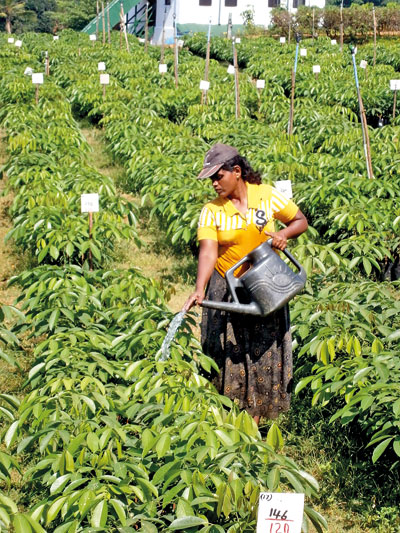Rubber industry in peril beyond resurrection?
Rubber Asia, an Asian magazine on rubber in its latest issue (July-August 2018) has published the average annual yield (productivity) levels of all major rubber growing countries including Sri Lanka.

File picture of a rubber nursery.
It is pathetic to see that the 150-year old Sri Lankan rubber industry which has been a pioneer in many breakthroughs in the Asian rubber industry has recorded very pathetic and dismal performances over the years. It is manifestly seen from the following table that the average yield (productivity) levels have been declining at the rate of 15 kg per annum. If this adverse trend is not arrested as a matter of national priority, it would be inevitable that this vital industry that generates over Rs. 1 billion to the national coffers would be wiped out from the Sri Lankan soil.
The authorities appear to have optimistically pinned their hopes on the Rubber Master Plan (RMP) on the premise that it would automatically resolve all the operational issues afflicted with the rubber industry, once the RMP is implemented. This, of course, is a myth and a delusion. The learned authors who compiled the RMP have failed to find conclusive answers to the declining trends of productivity. Let me quote the relevant paragraph in the RMP: “It is inexplicable why Sri Lanka records lowproductivity because the RRI (Rubber Research Institute) has developed some of the best yielding clones in the NR world while the RDD (Rubber Development Department) has a long history of providing extensive extension services including generous subsidies. Rubber production segment may not survive for long unless effective measures are taken to enhance farm productivity to match with international benchmarks”.
It is my considered view that the segregation of the extension wing of the RRI and its amalgamation with the RDD is the cause of this downfall. The country and the whole world have witnessed the ill effects of the bureaucratic bungling under its 25 years management of the RDD. The research-extension link disintegrated as a result of this amalgamation and emphasis given to the payment of subsidies over the extension over a period of a quarter century is the disastrous results what we are witnessing today.
Will the Minister of Plantation have the wisdom, capacity and the courage to have an institutional change even at this belated stage?



